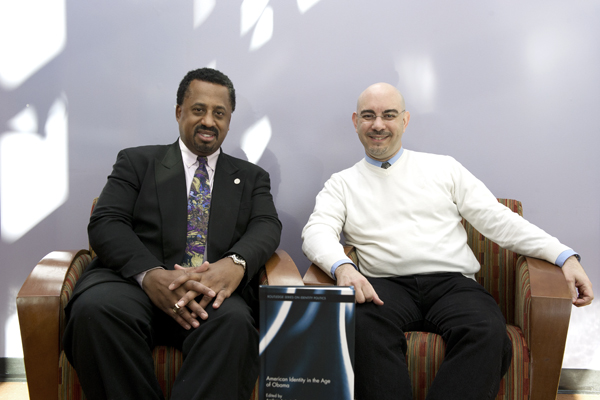Racial divisions in Obama’s America

In March, Northeastern University professors Amílcar Barreto and Richard D. O’Bryant will convene a score of scholars for a daylong conference on gender and identity in the age of Obama. The experts will present scholarly papers on topics ranging from feminism to family, the best of which will be co-edited by Barreto and O’Bryant and then compiled into the second volume of their series on American identity in the age of Obama. The first volume, published in December by Routledge, derived from their 2011 conference on race and identity, which focused on the role of race, ethnicity, and immigration status in shaping conceptions of what it means to be American. Here, Barreto, an associate professor of political science and an affiliated faculty member of the International Affairs and African American Studies departments, and O’Bryant, the director of the African American Institute and a lecturer of political science, explain why Obama’s election has opened a new chapter in American history.
It’s now been more than five years since Obama was elected the 44th President of the United States. Since then, how have his presidency and his policies shaped the public’s view of race and ethnicity in America?
Rather than ameliorate public views on race, Obama’s presidency has actually polarized them. Despite the prevalence of a public discourse of a post-racial society, a sizeable portion of the public was not ready to contemplate substantial change. Their goal was to maintain the racial status quo while flaunting the rhetoric of a post-racial America. Obama’s optimism on racial matters was fueled, no doubt, by his experiences in a multiracial Hawaii and Chicago. He failed to adequately take into account a vast swath of the country where interracial harmony was never desired or even resisted. Hence this reality and the racial resistance caused much of Obama’s message of racial parity, social redirection, and racial tolerance to reach an imbalanced listening audience. For some it fell on a collective deaf ear. Ultimately, the country seems to be at a stalemate when it comes to even discussing the issue of race in America. The election of Barak Obama, the first African American president, does not seem to have been enough to thaw the deep seeded racial polarization.
In the introduction to the first volume of your series, you write: “Such persistent assertions about Obama’s origins suggest that racial tensions endure in the American body politic alongside an unhealthy dose of xenophobia.” In your view, what are the biggest keys to achieving racial equality in America?
Promoting racial equality will always depend first on dialogue. There is a great deal of truth to the suggestion posited by various scholars that there is a permanence to racism. Even in the wake of Obama’s reelection, race remains a taboo subject. Racism denial, in a myriad of forms, has become a habitual practice in day-to-day affairs. In the words of the eminent sociologist Eduardo Bonilla-Silva, we live in a society of “racism without racists.” Attempts to engage in civil conversations on this topic by both the Clinton and Obama administrations have been met with benign neglect and summarily withered on the vine. Perhaps Obama will be in a better position to address these issues as part of his post-presidential agenda. Regardless of his future actions, however, we have an obligation to keep the matter in the forefront of America’s conscience and address this matter now. And we see no better place to start and continue the difficult conversation about the issue of race in America than institutions of higher education.
In a 1996 questionnaire for a Chicago gay and lesbian newspaper, Obama, then a candidate for the Illinois state senate, wrote, “I favor legalizing same-sex marriages and would fight efforts to prohibit such marriages.” Yet it took him until the spring of 2012 to publicly endorse same-sex marriage, telling ABC News, “I think same-sex couples should be able to get married.” Has an endorsement from one of the world’s most powerful people made it easier for politicians to publicly favor marriage equality? If not, what would?
Those aspiring to attain and hold public office must always be cautious when promoting highly polarizing issues. And Barak Obama’s presidency has certainly thrust into the public spotlight the contentious issue of LGBT rights—the great civil rights battle of our day—more than any of his predecessors. As a shrewd political operator, President Obama calculated that it was safer to push for LGBT rights after his reelection. The advantage for future officeholders is that Obama’s policies will make it harder to put the genie back in the bottle. Although some may not look at it as easier, what has unquestionably occurred is a dramatic shift in mainstream America’s attitude toward marriage equality. Having it firmly posited in the discussion of equal rights of all Americans has made resistance to issue much less contentious.





